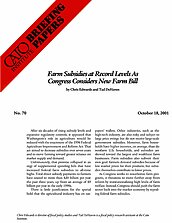Unfortunately, that promise collapsed in an orgy of supplemental spending bills that have increased federal farm subsidies to all-time highs. Total direct subsidy payments to farmers have soared to more than $20 billion per year the past three years, up from an average of $9 billion per year in the early 1990s.
There is little justification for the special hold that the agricultural industry has on tax-payers’ wallets. Other industries, such as the high-tech industry, are also risky and subject to large price swings but do not receive large-scale government subsidies. Moreover, farm households have higher incomes, on average, than do nonfarm U.S. households, and subsidies are skewed toward the largest and wealthiest farm businesses. Farm subsidies also subvert their own goal: farmers demand subsidies because of low market prices for their products, but subsidies themselves contribute to lower prices.
As Congress works to reauthorize farm programs, it threatens to move further away from reform by institutionalizing high levels of farm welfare. Instead, Congress should push the farm sector back into the market economy by repealing federal farm subsidies.



